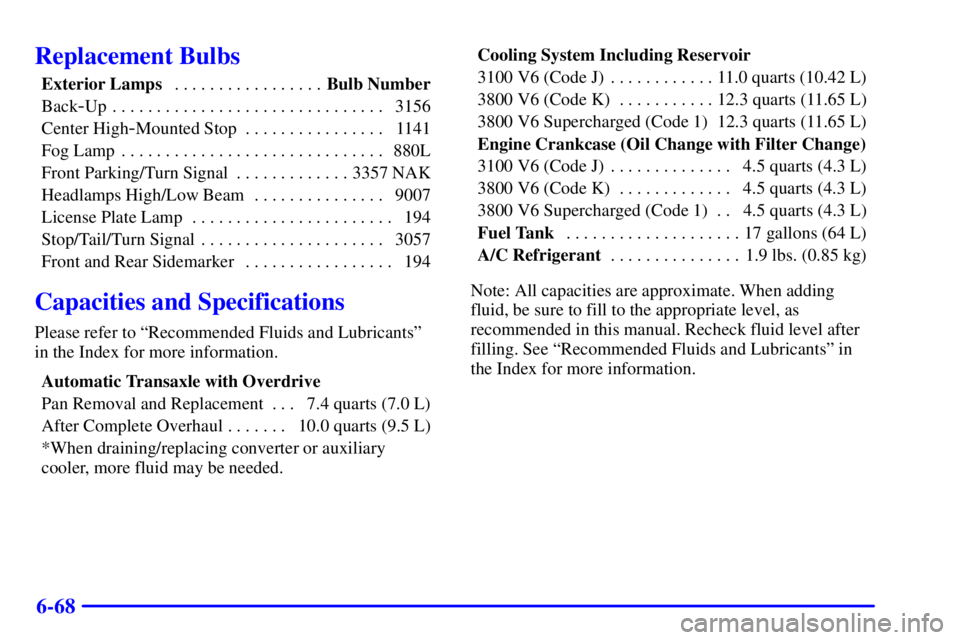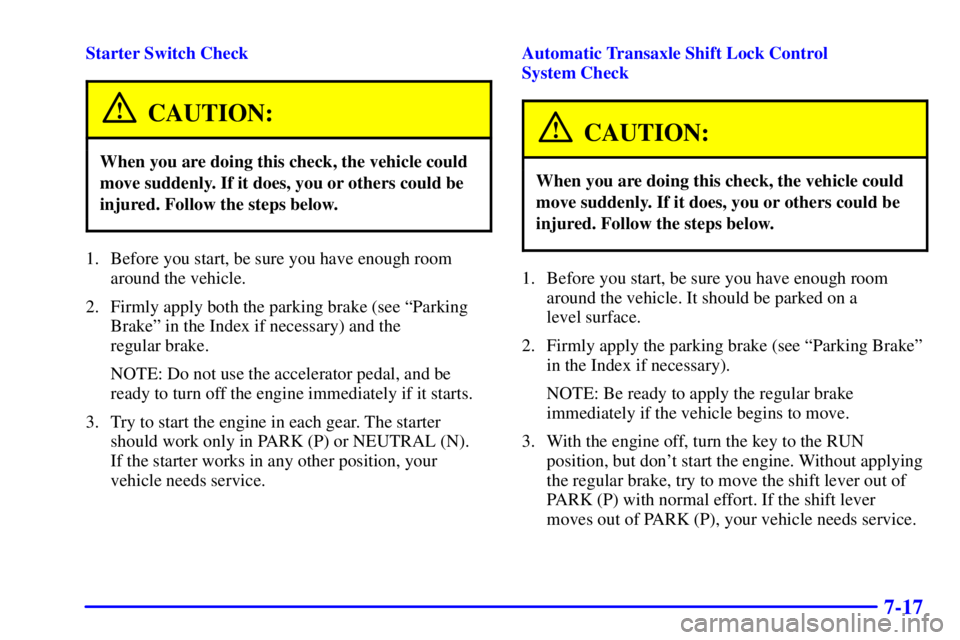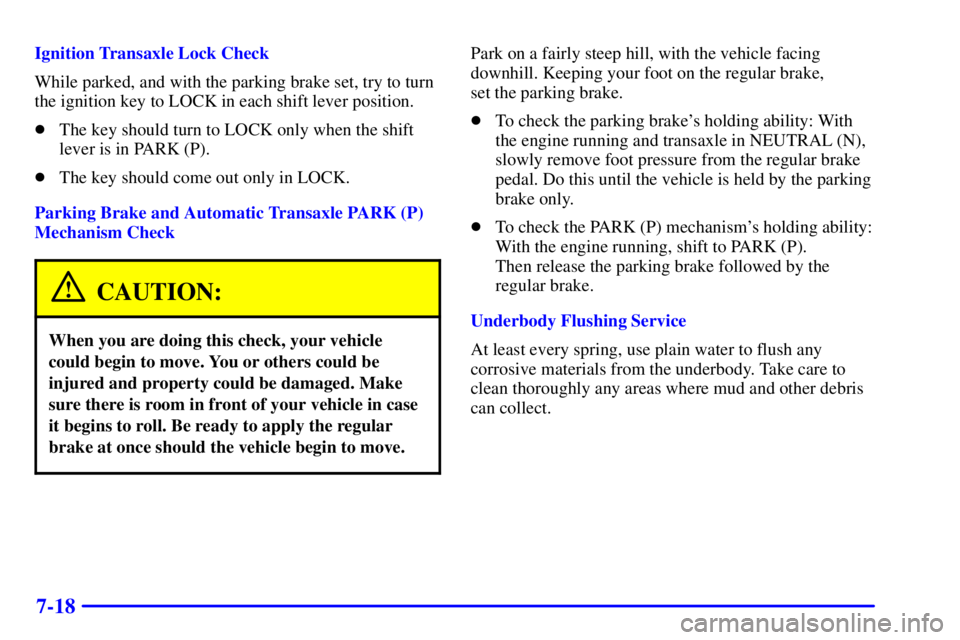Page 290 of 376
6-23
Wait at least 30 minutes before checking the transaxle
fluid level if you have been driving:
�When outside temperatures are above 90�F (32�C).
�At high speed for quite a while.
�In heavy traffic
-- especially in hot weather.
�While pulling a trailer.
To get the right reading, the fluid should be at normal
operating temperature, which is 180�F to
200�F (82�C to 93�C).
Get the vehicle warmed up by driving about 15 miles
(24 km) when outside temperatures are above 50�F
(10�C). If it's colder than 50�F (10�C), you may
have to drive longer.Checking the Fluid Level
Prepare your vehicle as follows:
�Park your vehicle on a level place. Keep the
engine running.
�With the parking brake applied, place the shift lever
in PARK (P).
�With your foot on the brake pedal, move the shift
lever through each gear range, pausing for about
three seconds in each range. Then, position the shift
lever in PARK (P).
�Let the engine run at idle for three to five minutes.
Page 334 of 376
6-67
Fuse Description
19 Spare
20 Spare
21 Mass Air Flow (MAF), Heated Sensors,
Canister Purge, Boost Solenoid
22 Spare
23 Spare
24 Spare
25 Ignition Module
26 Spare
27 Trunk Release, Back
-Up Lamps
28 AC Clutch, ABS Ignition
29 Remote Keyless Entry, Theft
-Deterrent,
Shock Sensor, Trip Computer, HVAC
Module, Security LED
30 Alt Sense
31 Torque Converter Clutch (TCC)
32 Fuel Pump
33 Electronic Control Module/Powertrain
Control Module
34 SpareFuse Description
35 Fog Lamps
36 Horn
37 Chime/Mall Module, Taillamps,
Parking Lamps, Sidemarker Lamps,
Dimmable Lamps
38 Spare Fuse
39 Air Pump
40 Spare
Diode Description
Air Conditioning Clutch Diode
Relay Description
9 Cooling Fan
10 Cooling Fan 2
11 Ignition Main
12 Cooling Fan 1
13 Air Conditioning Clutch
14 Fuel Pump
15 Fuel Pump Speed Cont
16 Horn
17 Fog Lamp
Page 335 of 376

6-68
Replacement Bulbs
Exterior Lamps Bulb Number. . . . . . . . . . . . . . . . .
Back
-Up 3156. . . . . . . . . . . . . . . . . . . . . . . . . . . . . . .
Center High
-Mounted Stop 1141. . . . . . . . . . . . . . . .
Fog Lamp 880L. . . . . . . . . . . . . . . . . . . . . . . . . . . . . .
Front Parking/Turn Signal 3357 NAK. . . . . . . . . . . . .
Headlamps High/Low Beam 9007. . . . . . . . . . . . . . .
License Plate Lamp 194. . . . . . . . . . . . . . . . . . . . . . .
Stop/Tail/Turn Signal 3057. . . . . . . . . . . . . . . . . . . . .
Front and Rear Sidemarker 194. . . . . . . . . . . . . . . . .
Capacities and Specifications
Please refer to ªRecommended Fluids and Lubricantsº
in the Index for more information.
Automatic Transaxle with Overdrive
Pan Removal and Replacement 7.4 quarts (7.0 L). . .
After Complete Overhaul 10.0 quarts (9.5 L). . . . . . .
*When draining/replacing converter or auxiliary
cooler, more fluid may be needed.Cooling System Including Reservoir
3100 V6 (Code J) 11.0 quarts (10.42 L). . . . . . . . . . . .
3800 V6 (Code K) 12.3 quarts (11.65 L). . . . . . . . . . .
3800 V6 Supercharged (Code 1) 12.3 quarts (11.65 L)
Engine Crankcase (Oil Change with Filter Change)
3100 V6 (Code J) 4.5 quarts (4.3 L). . . . . . . . . . . . . .
3800 V6 (Code K) 4.5 quarts (4.3 L). . . . . . . . . . . . .
3800 V6 Supercharged (Code 1) 4.5 quarts (4.3 L). .
Fuel Tank17 gallons (64 L) . . . . . . . . . . . . . . . . . . . .
A/C Refrigerant1.9 lbs. (0.85 kg) . . . . . . . . . . . . . . .
Note: All capacities are approximate. When adding
fluid, be sure to fill to the appropriate level, as
recommended in this manual. Recheck fluid level after
filling. See ªRecommended Fluids and Lubricantsº in
the Index for more information.
Page 354 of 376

7-17
Starter Switch Check
CAUTION:
When you are doing this check, the vehicle could
move suddenly. If it does, you or others could be
injured. Follow the steps below.
1. Before you start, be sure you have enough room
around the vehicle.
2. Firmly apply both the parking brake (see ªParking
Brakeº in the Index if necessary) and the
regular brake.
NOTE: Do not use the accelerator pedal, and be
ready to turn off the engine immediately if it starts.
3. Try to start the engine in each gear. The starter
should work only in PARK (P) or NEUTRAL (N).
If the starter works in any other position, your
vehicle needs service.Automatic Transaxle Shift Lock Control
System Check
CAUTION:
When you are doing this check, the vehicle could
move suddenly. If it does, you or others could be
injured. Follow the steps below.
1. Before you start, be sure you have enough room
around the vehicle. It should be parked on a
level surface.
2. Firmly apply the parking brake (see ªParking Brakeº
in the Index if necessary).
NOTE: Be ready to apply the regular brake
immediately if the vehicle begins to move.
3. With the engine off, turn the key to the RUN
position, but don't start the engine. Without applying
the regular brake, try to move the shift lever out of
PARK (P) with normal effort. If the shift lever
moves out of PARK (P), your vehicle needs service.
Page 355 of 376

7-18
Ignition Transaxle Lock Check
While parked, and with the parking brake set, try to turn
the ignition key to LOCK in each shift lever position.
�The key should turn to LOCK only when the shift
lever is in PARK (P).
�The key should come out only in LOCK.
Parking Brake and Automatic Transaxle PARK (P)
Mechanism Check
CAUTION:
When you are doing this check, your vehicle
could begin to move. You or others could be
injured and property could be damaged. Make
sure there is room in front of your vehicle in case
it begins to roll. Be ready to apply the regular
brake at once should the vehicle begin to move.
Park on a fairly steep hill, with the vehicle facing
downhill. Keeping your foot on the regular brake,
set the parking brake.
�To check the parking brake's holding ability: With
the engine running and transaxle in NEUTRAL (N),
slowly remove foot pressure from the regular brake
pedal. Do this until the vehicle is held by the parking
brake only.
�To check the PARK (P) mechanism's holding ability:
With the engine running, shift to PARK (P).
Then release the parking brake followed by the
regular brake.
Underbody Flushing Service
At least every spring, use plain water to flush any
corrosive materials from the underbody. Take care to
clean thoroughly any areas where mud and other debris
can collect.
Page 357 of 376
7-20 Throttle System Inspection
Inspect the throttle system for interference or binding,
and for damaged or missing parts. Replace parts as
needed. Replace any components that have high effort
or excessive wear. Do not lubricate accelerator and
cruise control cables.
Brake System Inspection
Inspect the complete system. Inspect brake lines and
hoses for proper hook
-up, binding, leaks, cracks,
chafing, etc. Inspect disc brake pads for wear and rotors
for surface condition. Inspect other brake parts,
including calipers, parking brake, etc. Check parking
brake adjustment. You may need to have your brakes
inspected more often if your driving habits or conditions
result in frequent braking.